Beginning with a new art medium can sometimes be overwhelming. So many brands, so many flavors.
In this section I’ll tell a thing or two about the products I use (or used to use)and what their advantages and disadvantages are (in my opinion at least).
Mind, I can only talk about my own experiences with these products, your experience can be totally different because your style may be different, or somehow materials that work for me, don’t work for you or vice versa.
Just know that I’m not affiliated to any brand at all and these are just my findings, for what they’re worth to you.
General
Pastels come in different shapes and colors. You can buy pencils, which are basically chalk in a wooden casing. You can also buy soft or hard pencils. Both are made of the same materials but hard pencils contain less pigment and more binder than soft pastels. Hard pastels are great for adding details that need a sturdy point.
And you can buy panpastels. Panpastels are more expensive than other pencils but one pan goes a long way.
Can you mix these materials?
Yes you can, most of the times anyway!
Pencils of different brands an be used together. I would suggest starting with a layer of softer pencils and ending with the harder pencils.
Pencils can be added to panpastel backgrounds.
Soft and hard pastels can be added to panpastel backgrounds. Different brands can be used together.
Pencils on soft and hard pastels is doable, but you need to make sure the background layer is as thin as possible and well blended. I would not recommend using soft and hard pencils for the background of your main subject (use panpastels or pencils).
Do I have favorites?
Yes obviously, but every drawing I make usually contains a large mixture of these materials and brands, because of color variation, the way they help me get my details in, the way they cover my paper while doing my underpainting, or any other reason.
They are so expensive!
Yes they are, especially when you have to keep sharpening them and they keep breaking. But where it comes to quality, you really want pastels that contain enough pigment, that are lightfast and that will keep your artwork in good condition, rather than having them turn yellow or dull over the years. But don’t go buying all these brands in full size boxes. Usually a box of 12-24 will contain such a great range of colors that you can blend and mix with ease into more colors. Basically, you only need black, white, red, yellow and blue to get each color so any box containing more, eases that process.
Pastel Pencils
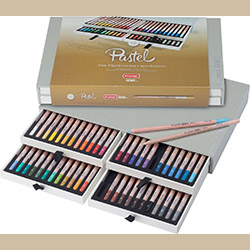
Bruynzeel Pastelpencils
These are softer pastel pencils with good color distribution for easy covering your paper
The color variation is sufficiënt. Bruynzeel pastel pencils have the tendency to break easily while sharpening. I recommend not using a regular sharpener but instead use a hobby knife. Affordable pricing
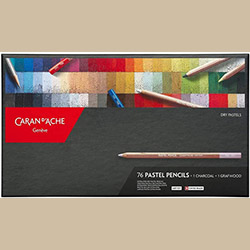
Caran D'Ache pastelpencils
Where it comes to coverage and sublime colors, Caran d'Ache is my go to pencil. They are great for drawing, great for detail and especially the Chinese White is as white as it gets (more than other brands). But.... sharpening these pencils is a costly hobby since they break, even with good sharpeners. I use a hobby knife and a sanding paper to get my pencil tips sharp. Pricy pencils
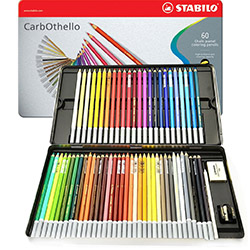
Stabilo CarbOthello
Favorite to many artists. CarbOthello pastelpencils by Stabilo have great color coverage for both background as main subject and layers very well. I have not yet discovered a downside to these pastel pencils and they fit in with other favorite brands, adding many great colores to the palet. These pencils, together with the Faber Pitt Pastels are the ones I use most.
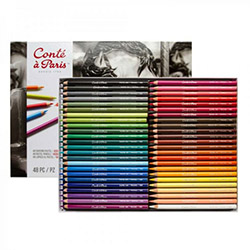
Conté à Paris pastelpencils
Conté à Paris pastel pencils are thicker pencils, like Caran d'Ache and Derwent. They have good color distribution and a decent palet of bright and radiant colors. Because they are thicker, I find it more difficult to use these pencils for the tiniest details but they do great in the less tiny details. Pricy pencils
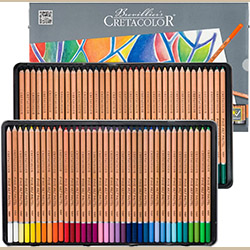
Cretacolor pastelpencils
Very nice and complete color palet. Great set, softer pencils. They are comfortable pencils to draw with and get most of my details in. Not too difficult sharpening but, as most pastel pencils, be careful because chalk easily breaks off.
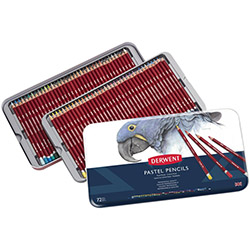
Derwent pastelpencils
Especially for animal and human portraits, Derwent adds great brown-ish colors to the palet. Easy breaking pastel pencils, so they need to be carefully sharpened with a hobby knife. They layer very well and I use them quite often for my underpaintings, background and portraits, along with some other brands
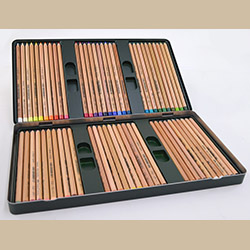
Faber Castel Pitt pastel
Pitt Pastel pencils are a harder brand of pencils, making them ideal for detailing (last layer(s) and less for underground layers. They sharpen really easy and come in 60 great colors.
Soft Pastels
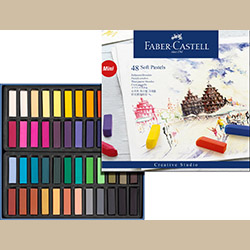
Faber Castel Soft Pastels
Affordable soft pastels. Good colors, leave pretty much dust so don't use when you don't want to get dirty hands. For me not very suitable for the detailed layers but I use them for the background (to achieve the Bokeh effect)
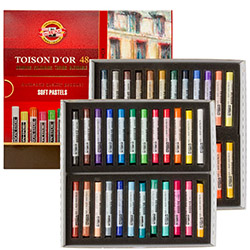
Koh-I-Noor Toison D'Or
Softer, dusty chalks with good color variation. I have trouble with these with drawing finer details

Rembrandt soft pastels
Good value for your money. I only have a small set of these so I only use them occasionally
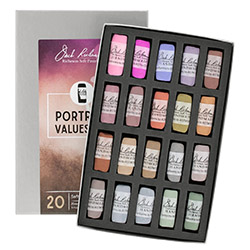
Jack Richeson soft pastels
Handmade soft pastels, in a more pricy range. Great colors and good color distribution. Can be used for entire pastel paintings up to the tiny details (for example by breaking the pastels to get new sharp points).
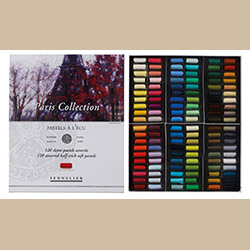
Sennelier soft pastels
Fairly pricy and dusty chalks. Great colors, good distribution. Do not work for me in the tiny details.
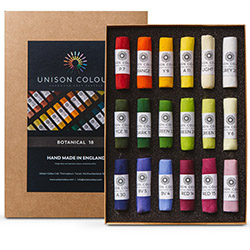
Unison soft pastels
Like the Richesons, these are handmade top tier pastels and they come in a huge amount of colors. They are sturdy, which allow you to break them to get sharp edges and tips to add thinner lines and details.
Hard Pastels & Pan Pastel
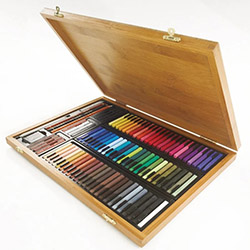
Conté à Paris square hard pastels
These come in various box sizes adding lots of colors to the palet. Because these pastels are harder, I use them to add details to my top layer(s). Good quality, but pricy
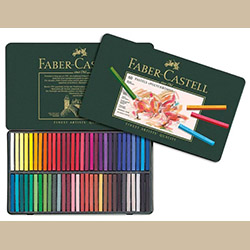
This is the heading
Alongside the harder pencils, Faber Castell also offers harder pastels, perfect for finer details. Great addition to other brands.

Pan Pastel
Pan Pastels are pans made of chalk, pigment and binder. They are used with a variety of tools, sponges, brushes etc and you need to build the color up in thin layers. A little bit of panpastel goes far! Can be used to fill in large areas but, because of the tools, can also be used to add the tiniest details. Huge color palet with shades, highlights end medium colors.
Pastel Paper
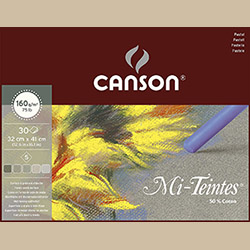
Canson Mi Teintes
Cheaper paper with a visible grain. Not easy to fully cover it, but perfect for practice. Remains dusty after finished.

Canson Mi Teintes Touch
Mi Teintes Touch is a more sanded paper like pastel paper. It picks up color easy and covers pretty nice. Still very affordable but like the regular Mi Teintes, it keeps staining so store well protected. Also works great with colored pencils (!)
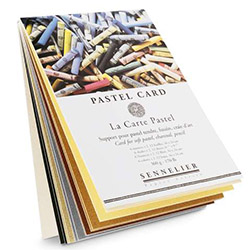
Sennelier Pastelcard
Pastelcard is a bit like pastelmat, but more grainy. Layers easy and can take quite a few layers. Also works great with colored pencils (!).

Clairefontaine Pastelmat
Most advised and my personal favorite. Pastelmat can take so many layers that it actually helps you correct mistakes without having to erase them. But even if you want to erase something, the paper itself is water-resistant (of course to a certain extend) so when needed, you can use a coton swab, dip it in water, and carefully remove a few layers of pastel. Is also suitable to use in combination with colored pencils.
Plus: the paper itself does not easily stain after you finished your drawing. Still, store with the accompanying protective sheet for safe keeping. Downsize: expensive paper (but I think it's worth it)
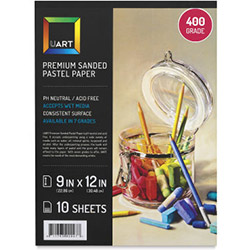
Uart paper
Looks and feels like sandedpaper, but a bit more sturdy than the sanded paper you get from your local hardware store. Comes in grades like sanded paper as well. Usually 400-500-600 will do for a pastel drawing. They advertise that you do not need fixative, because the paper does not stain. I tend to disagree, it stains. So store carefully. But also, because it moves the pastel around very easily, blending may be a challenge in the beginning. Paper comes in two shades (natural and dark anthracite/black-ish and is also suitable for colored pencils.
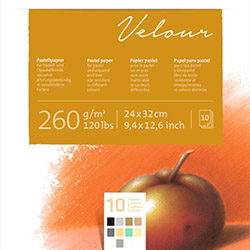
Hahnemühle Velour paper
If you want to draw softer looking pastel pieces, you may want to consider trying Velour paper. It's an acquired taste and it takes some trial and error to make the paper pick up the amount of pastel you want it to pick up, because of the surface of the velour. But, once you get the feel of it, it kinda works very nice and indeed, gives your artwork this furry softness, that really adds an extra dimension to specific pieces that need to look soft.
Erasing Pastels
Pastels aren’t easy erasable. Therefor, paper that allows you to add more layers, can actually help you with correcting your mistakes, just by adding a new layer.
But “not easy” does not mean “not at all”. Keep a kneeded eraser close by, since that won’t damage your paper or push chalk into the grain. Kneeded eraser lifts the pastel from your paper.
Besides kneeded eraser, you can use Scotch Magic tape to lift some of the chalk. Do not stick it to the paper and leave it be, because then it will leave residue to your paper.
And, depending on the paper, some papers can handle water, so gently washing off pastel can be done with some brands. Always try on a separate piece of that brand, before trying on your drawing.
Sharpening Pastels
The biggest challenge of them all, sharpening your pastel pencils.
Where Stabilo CarbOthello and Faber Castel Pitt Pastel pencils are rather forgiving on sharpeners that are getting blunt, most other brands will show breakage. Make sure to have plenty of sharpeners, because you may need a few for one drawing alone.
You can also use a hobby knife to cut away the wood around the pencil and then use a sanded paper block to sharpen your point (or the larger hole in a sharpener, where you only sharpen the chalk tip.
Remember: you don’t need a sharp tip throughout your entire drawing. When you plan in advance, you can use the sharper tip for details on one part of the drawing and once it’s blunt, use it for fillingin underlayers on different parts of your drawing. Then you only have to sharpen the tip if you need more details. While drawing, turn around your pencil to keep the tip sharp for as long as possible.
